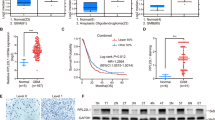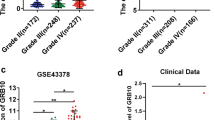Abstract
Golgi phosphoprotein-3 (GOLPH3), an important protein in mammalian target of rapamycin (mTOR) signaling, is overexpressed in and correlates with the pathological grade of glioma. However, the potential correlation between GOLPH3 and clinical outcome in patients with glioblastoma multiforme (GBM) remains unknown. In this study, we examined GOLPH3 expression in GBM by tissue microarray and correlated this measure to patient outcome. GOLPH3 expression in tumor tissue from 97 primary GBM patients was examined by tissue microarray and immunohistochemistry. Potential effects of GOLPH3 on tumor growth were also examined in representative cell lines (U251 and U87) by downregulating GOLPH3 with RNA interference. For this cohort, the median overall survival (OS) was 12 months [95 % confidence interval (CI): 10.31–13.69 months], and the median progression-free survival (PFS) was 10 months (95 % CI: 7.33–12.67 months). Tissue microarray analysis revealed high GOLPH3 expression in 40 patients (40/97, 41.2 %) and low GOLPH3 expression in the remaining 57 patients (57/97, 58.8 %). Log-rank test showed that patients with low GOLPH3 expression had significantly longer median OS (15 versus 10 months in patients with high GOLPH3 expression, p = 0.009) and median PFS (12 versus 7 months, p = 0.015). Univariate and Cox analysis indicated that GOLPH3 was an independent prognostic factor for OS and PFS. In in vitro experiments, GOLPH3 downregulation by small interfering RNA (siRNA) suppressed proliferation and clonogenic growth in cultured cell lines. These findings demonstrate that high GOLPH3 expression is associated with poor outcome of GBM patients.



Similar content being viewed by others
References
Furnari FB, Fenton T, Bachoo RM, Mukasa A et al (2007) Malignant astrocytic glioma: genetics, biology, and paths to treatment. Genes Dev 21(21):2683–2710
Wen PY, Kesari S (2008) Malignant gliomas in adults. N Engl J Med 359(5):492–507
Van Meir EG, Hadjipanayis CG, Norden AD, Shu HK, Wen PY, Olson JJ (2010) Exciting new advances in neuro-oncology: the avenue to a cure for malignant glioma. CA Cancer J Clin 60(3):166–193
Chi AS, Wen PY (2007) Inhibiting kinases in malignant gliomas. Expert Opin Ther Targets 11(4):473–496
Sathornsumetee S, Reardon DA, Desjardins A, Quinn JA, Vredenburgh JJ, Rich JN (2007) Molecularly targeted therapy for malignant glioma. Cancer 110(1):13–24
Nicholas MK, Lukas RV, Jafri NF, Faoro L, Salgia R (2006) Epidermal growth factor receptor- mediated signal transduction in the development and therapy of gliomas. Clin Cancer Res 12(24):7261–7270
Westermark UK, Lindberg N, Roswall P, Brasater D et al (2011) RAD51 can inhibit PDGF-B-induced gliomagenesis and genomic instability. Neuro Oncol 13(12):1277–1287
Hagerstrand D, He X, Bradic LM, Hoefs S et al (2011) Identification of a SOX2-dependent subset of tumor- and sphere-forming glioblastoma cells with a distinct tyrosine kinase inhibitor sensitivity profile. Neuro Oncol 13(11):1178–1191
Zhou YH, Tan F, Hess KR, Yung WK (2003) The expression of PAX6, PTEN, vascular endothelial growth factor, and epidermal growth factor receptor in gliomas: relationship to tumor grade and survival. Clin Cancer Res 9(9):3369–3375
Norden AD, Drappatz J, Wen PY (2008) Antiangiogenic therapy in malignant gliomas. Curr Opin Oncol 20(6):652–661
Xu T, Chen J, Lu Y, Wolff JE (2010) Effects of bevacizumab plus irinotecan on response and survival in patients with recurrent malignant glioma: a systematic review and survival-gain analysis. BMC Cancer 10:252
Wu CC, Taylor RS, Lane DR, Ladinsky MS, Weisz JA, Howell KE (2000) GMx33: a novel family of trans-Golgi proteins identified by proteomics. Traffic 1(12):963–975
Scott KL, Kabbarah O, Liang MC, Ivanova E et al (2009) GOLPH3 modulates mTOR signalling and rapamycin sensitivity in cancer. Nature 459(7250):1085–1090
Dippold HC, Ng MM, Farber-Katz SE, Lee SK et al (2009) GOLPH3 bridges phosphatidylinositol-4-phosphate and actomyosin to stretch and shape the Golgi to promote budding. Cell 139(2):337–351
Scott KL, Chin L (2010) Signaling from the Golgi: mechanisms and models for Golgi phosphoprotein 3-mediated oncogenesis. Clin Cancer Res 16(8):2229–2234
Wullschleger S, Loewith R, Hall MN (2006) TOR signaling in growth and metabolism. Cell 124(3):471–484
Network TCGA (2008) Comprehensive genomic characterization defines human glioblastoma genes and core pathways. Nature 455(7216):1061–1068
Parsons DW, Jones S, Zhang X, Lin JC et al (2008) An integrated genomic analysis of human glioblastoma multiforme. Science 321(5897):1807–1812
Akhavan D, Cloughesy TF, Mischel PS (2010) mTOR signaling in glioblastoma: lessons learned from bench to bedside. Neuro Oncol 12(8):882–889
Li XY, Liu W, Chen SF, Zhang LQ, Li XG, Wang LX (2011) Expression of the Golgi phosphoprotein-3 gene in human gliomas: a pilot study. J Neurooncol 105(2):159–163
Louis DN, Ohgaki H, Wiestler OD, Cavenee WK et al (2007) The 2007 WHO classification of tumours of the central nervous system. Acta Neuropathol 114(2):97–109
Kononen J, Bubendorf L, Kallioniemi A, Barlund M et al (1998) Tissue microarrays for high-throughput molecular profiling of tumor specimens. Nat Med 4(7):844–847
Ohuchida K, Mizumoto K, Ishikawa N, Fujii K et al (2005) The role of S100A6 in pancreatic cancer development and its clinical implication as a diagnostic marker and therapeutic target. Clin Cancer Res 11(21):7785–7793
Ohtsubo K, Marth JD (2006) Glycosylation in cellular mechanisms of health and disease. Cell 126(5):855–867
Partridge EA, Le RC, Di GGM, Pawling J et al (2004) Regulation of cytokine receptors by Golgi N-glycan processing and endocytosis. Science 306(5693):120–124
Takahashi M, Tsuda T, Ikeda Y, Honke K, Taniguchi N (2004) Role of N-glycans in growth factor signaling. Glycoconj J 20(3):207–212
Sarbassov DD, Guertin DA, Ali SM, Sabatini DM (2005) Phosphorylation and regulation of Akt/PKB by the rictor-mTOR complex. Science 307(5712):1098–1101
Clevers H (2006) Wnt/beta-catenin signaling in development and disease. Cell 127(3):469–480
Sabatini DM (2006) mTOR and cancer: insights into a complex relationship. Nat Rev Cancer 6(9):729–734
Acknowledgments
This work was supported by the National “863” Advanced Technology Project (no. 2007AA02Z483), National Natural Science Foundation of China (no. 30973076), Program for Academic Leaders in Health Sciences in Shanghai (no. XBR2011030), and “Shu Guang” Project (no. 11SG37) in Shanghai.
Conflict of interest
The authors reported no conflicts of interest with the publication of the manuscript.
Author information
Authors and Affiliations
Corresponding author
Additional information
Jinxu Zhou and Tao Xu contributed equally to the work.
Electronic supplementary material
Below is the link to the electronic supplementary material.
Rights and permissions
About this article
Cite this article
Zhou, J., Xu, T., Qin, R. et al. Overexpression of Golgi phosphoprotein-3 (GOLPH3) in glioblastoma multiforme is associated with worse prognosis. J Neurooncol 110, 195–203 (2012). https://doi.org/10.1007/s11060-012-0970-9
Received:
Accepted:
Published:
Issue Date:
DOI: https://doi.org/10.1007/s11060-012-0970-9




